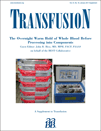The overnight warm hold of whole blood before processing into blood components
Approximately 70% of blood products for transfusion are collected on mobile blood donor drives. A blood collection team from a regional blood center comes to a school, church, community center, factory, or other local site and collects donors near their place of work or residence. Ease of donation is a critical requirement for securing adequate numbers of volunteer nonremunerated donors.
However, donation on mobile blood drives creates two important secondary problems. First, because of the distance from the blood center to the blood drive site may be many miles, it is typical to hold the blood units at the mobile site until the drive is complete. Because this time frequently exceeds 8 hours, a historic regulatory limit on how long blood can be stored warm before it is separated into components, it is typically placed into ice chests and stored cold. This means that the platelets (PLTs) are damaged and lost and only red blood cells (RBCs) and plasma can be recovered from the donation. The PLTs lost from mobile donations must be made up by apheresis collections, which are expensive and divert blood donors. The second consequence of collecting blood on mobile blood drives is that regional blood centers need to run processing teams at night, when the quality of personnel and supervision available is generally lower that than on the day shift. For both of these reasons, it would be potentially desirable to hold blood warm for periods up to 24 hours before processing.
The safety and efficacy of the blood components made from whole blood held warm for 24 hours has been widely debated. Pietersz and her colleagues provided the first useful demonstration that PLT recovery could be improved by this process and some suggestive data that the bacterial contamination might be reduced by giving the white blood cells a longer time to ingest and destroy them. The temperature-dependent loss of coagulation factor VIII, long a major reason for not holding plasma warm, has now been rendered moot by recombinant proteins or virally inactivated commercial plasma products. Only the negative effects of heat on RBC storage remained as a major obstacle. Despite this, several small countries such as Finland, Israel, Malta, and parts of the Netherlands, where RBC storage times were generally short anyway, moved to the 24-hour overnight warm hold of whole blood before processing.
For larger countries with more complex blood systems, regulatory concerns about the effects on bacterial contamination, the loss of plasma activity, and the loss of RBC viability have delayed serious consideration of the warm overnight hold of whole blood pending the availability of more data. In this context, the Biomedical Excellence for Safer Transfusion (BEST) Collaborative Trial 41 reported in this special supplement to TRANSFUSION by scientists in nine major blood product developmental laboratories is an important advance. It provides in vitro data on the quality of the cellular components and plasma under several different forms of storage.
In this special supplement to TRANSFUSION, Dame Ruby Pieterz (she was made a knight commander of the Order of the House of Orange for her work) describes the original development and implementation of the overnight hold in her native Netherlands. Gary Moroff and his colleagues from the American Red Cross follow with work on the overnight hold that they performed in the 1990s including the first RBC recovery measures. Pieter van der Meer and his collaborators then describe the general design of the trial and the results as they apply to RBCs and buffy coat PLTs. Margaret Veale and her colleagues follow with a report on the effect of the overnight warm hold on the membrane properties of subsequently stored RBCs. This editor then follows with an analysis of the problems raised by nonuniform measures of pH and ATP in the RBC portion of the trial and suggestions for improvement in the future. Margriet Dijkstra-Tiekstra and her colleagues then report on PLTs made by the buffy coat method, and van der Meer and his colleagues follow with a description of PLTs made by the US stardard platelet-rich plasma method. Rebecca Cardigan and the investigators follow with a description and discussion of the results of plasma storage on plasma protein concentrations and activity. Finally, Eilat Shinar and her colleagues from Israel present descriptions of how the overnight hold has been implemented in their country and how local problems with highly variable ambient temperature have been overcome. The authors hope the publication of this work advances discussion and progress toward the overnight hold and improving conventional blood components generally.
CONFLICT OF INTEREST
JRH is a US Government inventor who receives patent license royalties from the US Army in accordance with US law for inventions to store RBCs longer. He also advises Hemerus, LLC, licensee of those patents, and receives compensation.




